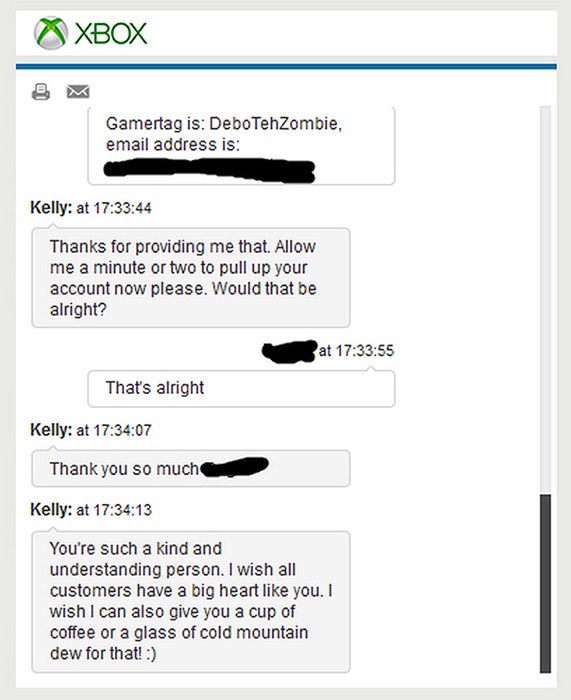There is a fine line between friendly and creepy. It’s true for social interactions and true for customer support.
Companies today already refer to their interactions with customers as "relationships," so allow me to offer some marriage counseling: consumers are tired of the insincere and often strangely affectionate tone that some companies force their support team to use.
If you want to see an example of where things get ugly, keep reading. I've heard (rumor only) that Microsoft has recently been making attempts to spruce up their Xbox Live support. On Reddit, a slew of screenshots like this have been making the rounds:

Yikes.
I don't have conclusive evidence that this is a new full-scale campaign by Microsoft, but many similar examples seem to make a convincing case.
"Kelly" seems to have become too attached to the customers she's helping. If this conversation had gone on any further, perhaps she would have offered to stroke the customer's hair ("My precious...").
Another nice touch: the Mountain Dew mention, a drink that has become cliché in the sloppy video gamer trope. In other words, this support rep is stereotyping the customer she is talking with. What, no "mom's basement" reference? Stay classy, Microsoft.
Following this example, it might seem like I'm about to advocate for totally neutral, corporate speak for your customer service, but fear not.
It’s not that you or your company should never be friendly or that support reps should be encouraged to have the personality of an automated call-center.
What matters is how you evaluate the customer and the situation in order to offer the right sort of response.
Tone is dependent on the customer
Just like the appropriate tone can have tremendous returns to your forward facing communications (like your website's copy), the right tone is absolutely essential for support.
The problem is that companies often blindly follow best practices—in this case, it is the assumption that super-friendly and "bubbly" reps are what customers always want.
One size does not fit all, thus finding the right tone for your company begins with truly understanding what your customer base looks like.
Who your customers are should greatly affect how you communicate with them. Though the spectrum (like most things) has quite a bit of variability, we can simplify by examining the three main tones companies are likely to use.
Casual tone. Xbox Live is actually a fit for the "casual" tone, so you can see that casual doesn't mean creepily affectionate. Perhaps the simple description of upbeat would be a more appropriate personality. I know that Buffer has a very cheery support team that compliments their brand's personality and their multitude of free users. As you would probably guess, B2C is most at home here, especially if the company is in a “fun” industry, like Eat24.
Business tone. Don't get me wrong—business people love personality, too. When I say business tone, I'm mostly referring to your typical B2B customer base. At Help Scout, our team definitely consists of some very friendly folks, but our customers are using us to power their businesses. The priority for our tone is to come across as professional yet personable, as that is what most closely fits our customers’ expectations.
Concierge tone. This is my name for the sort of tone one would expect in more serious customer-to-business relationships—I certainly don't plan on making many jokes with my financial advisor, as an example. In the most basic sense, the concierge tone is reserved for enterprise-level relationships or “business tone” relationships around touchy subjects.
You will know your customers far better than I; which sort of interactions do they value most? Does the product or service you offer skew towards highly personal or "serious" interactions (financial, medical)? Why are customers typically reaching out to your support team?
All of this and more should be considered in crafting your support strategy and in how you coach the support staff in handling a variety of common queries.
Tone also depends on the situation
Perhaps even more important, the correct usage of tone is entirely dependent on context.
Here's an example: a while back I was using Adidas live chat for the most adult of reasons—I wanted to buy a pair of sneakers, and they didn't have the color I wanted!
This was a neutral starting point with the company. In other words, it's not like I had just spent hard earned money and received a faulty product. I was just curious if a certain shoe model came in a color that I hadn't seen online.
I give full credit to the support person here: not only did she find the color I wanted, she called up a store and reserved it for me. More importantly for this article, her tone was very appropriate. While searching for the shoe, she actually made me laugh as we joked about what a "first world problem" this was.
I wasn't creeped out or offered a "glass of cold Mountain Dew," and I walked away happy to leave a recommendation. It was great overall service and a good use of a bubbly, friendly tone without going overboard.
Now let's look at a totally different scenario.
If you'll recall from an earlier article, I had a run in with a company who totally botched my order when I tried to purchase something for a friend.
The rep in this example stated how "annoying" that must be for me, in a joking way. Problem was, I was in no mood to joke. I had just spent a fair amount of money, only to have my gift arrive late for my friend's birthday, and I was charged twice when I wanted a single order.
It's not easy to judge how a customer will react in any instance, but the smart money says that if someone is contacting you due to a botched purchase, or they immediately showcase signs of frustration or anger, trying to defuse the situation with an overly cheery tone will only make things worse.
Sincere empathy works far better in these situations. To be sure, you should stick with positive language and focus on the solution, but if someone just spent money with your company and isn't satisfied with what he or she paid for, that customer wants results, not personality.
Customers are most likely to forgive a company if the resolution offered is straightforward: "I'm so sorry about that, and I understand how upsetting this must be. Let me get this fixed for you."
No games, no fun, and no corny jokes—just the way I want it.
Let's look at some examples
Tone in support is a bit of an abstract concept, so let's solidify what an appropriate tone might look like by cooking up some examples on the opposite end of the support spectrum.
I'll list the theoretical initial message from a customer in blue, and I'll follow with a quick analysis of what tone I consider to be most appropriate (messages are based on real ones I've received but are not verbatim).
Example 1
"Guys, loving the newsletter recently! The latest one in particular has been huge in helping my team with Problem X. Kudos! :) Quick question I had: we were looking to sign up under the promo you offered yesterday, but we won't start using the service until Dec. 5th. Could you start our trial on that date instead of right now?"
Above, I outlined a "neutral" contact experience and how it should encourage you to add a bit more personality than you would in a negative contact.
This is without a doubt an example of a positive contact, and it is the best time to swing for the fences when it comes to adding that extra bit of personality.
It would actually be a lackluster response here to simply answer the customer's question about the promo. It’s obvious through their tone that they are also looking to engage in a more casual conversation with your team, otherwise they wouldn't have started their message on the topic of your company newsletter.
Spare them (and me) the superficial "<3", but feel free to get creative with how you respond here—the customer is currently receptive, and a memorable message from you can go a really long way.
Example 2
"Team . . . I just upgraded my account last month to your Pro plan, and I've got to say I'm pretty frustrated. My settings have been totally reset, I'm seeing two invoices on my card this month, and worst of all, I'm not even seeing (Feature X) available, and I know on your pricing page this unlocks for Pro users. What gives?"
I won't mention names out of mercy, but I sent an email almost exactly like this to a service I use last month. Do you know what the first sentence of their response was?
D'oh, sorry Greg! I guess when it rains it pours. :)
Fortunately for them this was over the internet, because I was ready for some Game of Thrones style retribution when I read this. I "get" what they were trying to do, but the risk/reward here is very much not in the vendor’s favor.
Reward. A slight smirk makes its way across the customer's face as they acknowledge your humorous quip; it then quickly dissipates because they still have a legitimate problem.
Risk. The customer takes things the wrong way and goes from frustrated to angry.
Do you like those odds? I don't. That's why in this instance, and in any similar situation, I would advise you to stick to your bread and butter: sincerity, empathy, and a calm, collected attitude that is the hallmark of someone who is great at customer support.
Example 3
"Hey all, we've been testing out your product for the past week, and so far everything is ok. One thing though—we'd really like to see some odd feature; it would be pretty important for us if and when we decide to switch over completely from our old service."
We've covered features requests in our Guide to Better Support Emails, but I list one here because they often fit the ambiguous, hazy messages that support teams are so likely to receive.
The customer is not upset, but they aren't shouting your name from the rooftops either, so how should you respond?
Professional yet positive is a great spin that keeps the conversation at an appropriate level of enthusiasm—responding to their neutral message with an overly positive one puts you on the fast track to being viewed as insincere.
Something like, "Steve, I really appreciate you taking the time to send your thoughts our way, and I'm glad to hear that things are working out so far with our product. (Feature X) is definitely one the team and I have discussed before, and at the moment..."
This will outperform the robotic/bland, "Yes, we will add that feature/No, we aren't adding that feature," but it still keeps the dialogue consistent with the customer's original message.







